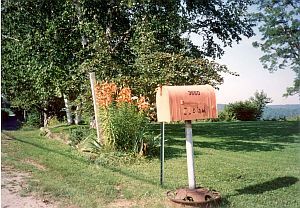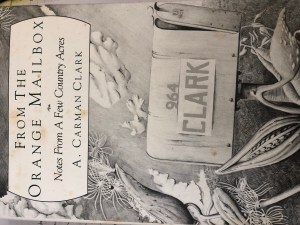About Lilacs – Stolen from The Orange Mailbox
Kate Flora: We are probably driving around the Yorkshire Dales as you read this, so in honor of May, and flowering things, I am cheating (as I sometimes do) and posting one of my mother’s posts from May in her collected columns: From the Orange Mailbox: Notes from a Few Country Acres. If you, like me, find bouquets of lilacs intoxicating, you will enjoy this.
From the writing of A. Carman Clark:

The Orange Mailbox at 1000 E. Sennebec Road.
Long ago in a New England mystery, I found a reference to lilacs as markers of old cellar holes. The city-bred heroine pursued by the murderer took to the woods and cowered behind a clump of flowering lilacs. The villain, allergic to bees, was stung and perished miserably behind the cornerstone of an old foundation. The story ended with all the threads tied up but left me with the question, “If the farm buildings had completely disintegrated, would the lilacs still bloom?”
Since moving to Maine, driving along back roads and hiking over long discontinued roadways have provided ample proof of the hardiness and tenacity of this flowering shrub. Rampant purple blossoms along wooded roads, visible among the soft greens of trees leafing out in May, do indeed indicate old cellar holes. Glimpses of purple have led to the discovery of overgrown graveyards.
Cutting lilacs was a spring ritual when the children were young. An abandoned farm up the road was lavish with lilacs, and we could cut armloads and have bouquets in every room. A lovely old gray pickle crock was the right container for a living room display. We hadn’t read about the superstitions associated with lilacs or purple. We enjoyed. It was pleasant to waken to a fragrant house.
New Englanders once believed that purple hues should not be permitted indoors. These symbolized mourning and sadness and might bring bad luck. Young women were reminded: She who wears lilac will never wear a wedding ring. Sending a bouquet of lilacs was a way of telling one’s betrothed of a wish to break off an engagement. Related, perhaps, to “In the spring, a young man’s fancy…”
 Blooming early and bountiful after winter in a climate where winters are cold—for lilacs grow as far north as Hudson Bay—this shrub was once planted beside almost every New England home. And, come spring, looking for a five-corolla-lobed lilac, like seeking a four-leaf clover, was supposed to bring good luck.
Blooming early and bountiful after winter in a climate where winters are cold—for lilacs grow as far north as Hudson Bay—this shrub was once planted beside almost every New England home. And, come spring, looking for a five-corolla-lobed lilac, like seeking a four-leaf clover, was supposed to bring good luck.
The word “lilac” comes from a Persian term for “bluish” but plant historians believe this hardy shrub was brought from the mountain slopes of southwestern China. Since only prized possessions warranted inclusion in the burden of long caravan journeys, the lilac’s transplanting suggests that fragrant early blooming has pleasured man’s sense of beauty for centuries.
By the seventeenth century lilac were a favorite in Europe and were blooming in both castle and cottage gardens in England. New Hampshire may have been the site of the first lilacs planted in America, and this is their state flower. In 1750, Benning Wentworth, colonial governor of New Hampshire, laid out a terrace to complete his rambling fifty-two-room mansion, he had lilacs brought from England.
Governor Wentworth is remembered for the beauty of his lilac shrubbery, and since he entertained often and sumptuously, his guests copied his landscaping and spring blossoms of this shrub spread up and down New England.
Wentworth is also remembered for his impulsive second marriage. After his guests had enjoyed the dinner celebrating his sixtieth birthday, Wentworth ordered the rector of St. John’s Church in Portsmouth to marry him then and there to his beautiful servant, Martha Hilton, who had just turned twenty. Martha Wentworth inherited the coastal estate and entertained George Washington there. (And some references state that the second lilacs imported to America were planted at Mt. Vernon.)
In England, the lilac was sometimes called the “pipe-tree” because the stems of pipes could easily be formed from lilac wood and a few tales suggest that the great god Pan used hollow lilac shoots instead of river reeds for the musical pipes which enticed maidens into the spring woodlands.
When Decoration Day was planned as a nation-wide observance in 1868 for the purpose of strewing flowers or otherwise decorating the graves of those who died in defense of their country during the Civil War, New England had lilacs in bloom on that date. And we still do. The color may symbolize mourning, but the fragrant blooms proclaim renewal and the strength of the life force.
Lea Wait's Blog
- Lea Wait's profile
- 509 followers



